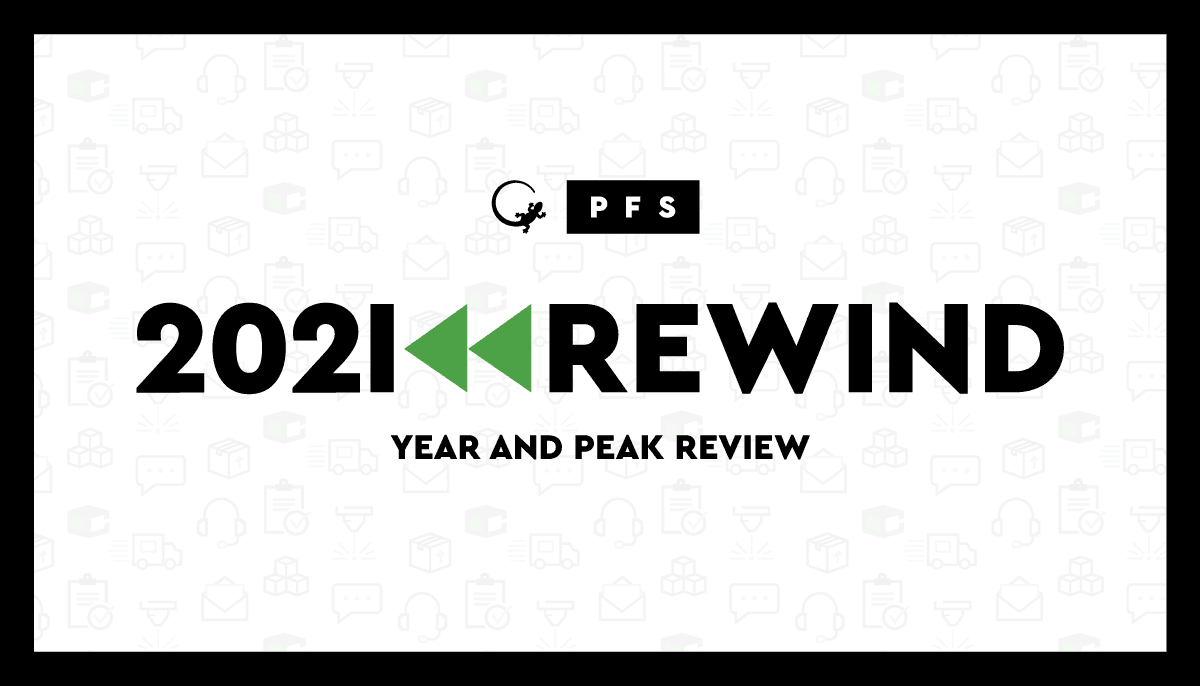
A Flawless Fall: 6 Keys to Peak Preparedness
Black Friday through Cyber Monday, 2020, was the first stress test of the capabilities retailers had put into place to address last year’s anticipated crush of online orders and the corresponding avalanche of fulfillment challenges. As omnichannel retail BPO provider PFS discovered in their Post-Peak 2020 analysis, 53% of the retailers surveyed felt they did not have the resources to make the operational changes needed ahead of the season, while 48% felt they didn’t have enough time. They had no intention of making that mistake again this year. Peak preparedness is top of mind for retailers as we head into fall.
However, even with the best intentions, many retailers are finding themselves jammed by ongoing supply chain and logistics constraints. As Multichannel Merchant’s Outlook 2021 reports, global delivery timeframes have more than doubled, major carriers are increasing their rates and capping their capacity, while many regional carriers may not take purely seasonal business at all. Compound this with a shortage of warehouse space suitable for omnichannel fulfillment, and many retailers may be facing a comparably frantic 2021.
6 Keys to Peak Preparedness
To help you gauge if you’re on-track to handle Peak Season 2021, we’ve identified six key benchmarks to have in place before things kick off.
Inventory visibility
One great strength of omnichannel retail is the ability to spread large quantities of merchandise across multiple distribution centers and retail locations. This multi-node fulfillment approach optimizes product availability by diversifying fulfillment points and supports greater speed of delivery. But this only works if you have real-time visibility across all your locations.
It’s vital to know where your SKUs are located and how many of each are available for sale. For example, as available stock at one location shrinks, distributed order management (DOM) functionality should route orders to alternative facilities for fulfillment. A full-featured OMS (order management system) also factors in delivery preferences, shipping time and costs, inventory optimization across stores, and even more sustainable delivery methods to maximize operational efficiency and deliver the best possible customer experience.
Picking & packing
Even with full transparency into your inventory, your ability to satisfy customers depends on how quickly and accurately operations can get that merchandise out the door. This demands technology, infrastructure and operational excellence. The bar for execution has been raised incredibly high by the premier eCommerce providers.
Additionally – depending on the nature of your products and your brand – there may be special considerations in the packaging operation that can elevate the unboxing experience and engender customer loyalty. If so, you will need to allow extra time for training your seasonal staff to execute these value-add services properly.
Shipping
The explosion of online shopping has created a “perpetual peak” that has maxed out carriers’ capacity year-round. There is also a dearth of long-haul drivers. If your eCommerce operations are shipping nation-wide or globally from a single location, this can result in a bottleneck that dramatically slows delivery times.
The challenge of finding carriers for the coming season, as discussed earlier, will be one of the greatest hurdles for brands in the upcoming peak season. If you haven’t already, it is vital that you consider ways to mitigate carrier capacity constraints by looking outside the big three (USPS, UPS and FedEx), and leveraging alternate carriers such as smaller, local carriers, if available.
If you cannot secure the capacity you need in advance of the rush, BPOs with standing carrier agreements can be a great resource, provided you don’t wait till the last minute to make sure you’re covered.
In-store fulfillment
This was a bright spot of customer adoption in 2020. The PFS study found that 67% of retailers who invested in “buy online, pick up in store” (BOPIS) capabilities saw increased sales, as did 55% of retailers who invested in curbside pick-up. Not surprisingly, the popularity of these fulfillment methods made them the greatest challenge for those retailers who weren’t prepared to execute on them.
For the season ahead, 36% of respondents were planning on investing in extra fulfillment capacity. By leveraging DOM as well as store-fulfillment technology such as PFS’ RetailConnect, you can focus on refining operations and equip your seasonal staff to execute on these orders, taking some of the strain off of your fulfillment centers without disrupting store operations.
Returns
One area receiving more attention in the new “digital-first” retail environment is returns. While every retailer wants to minimize customer returns, they are inevitable and according to Narvar, the number of eCommerce packages that were returned in the U.S. increased 70 percent in 2020 when compared to 2019. To assure the loyalty of your best customers, returns should be considered part of the overall customer experience, with the process as frictionless and satisfying as possible.
Devise your policy now to maximize a positive customer experience while minimizing spoilage. Script the most common scenarios, and be prepared to train up your customer service and warehouse staff well in advance of the peak shopping season.
Scalability
This item applies across all the categories above. While Peak Season drives increased volume for months, some days are more intense than others. Your systems and processes need to be able to handle those days. Additionally, your operations should be designed and provisioned for maximum peak volume.
If they’re not, you may be able to stagger through the biggest days. Hopefully, your customers won’t notice the strain. If that is too great a risk, there is a Plan B. That plan is also a key learning coming out of last year.
Per the PFS study, 54% of retailers came out of last season intending to outsource some or all of their digital operations. These include many who outsourced in 2020 because it was the best way for them to achieve operational and financial success in a seasonal context.
If you can’t check off all of the items on the preparedness punch list above, have no fear. PFS is a BPO pro equipped to help. Get in touch today!


